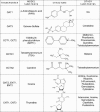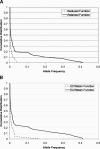Functional genomics of membrane transporters in human populations
- PMID: 16354753
- PMCID: PMC1361718
- DOI: 10.1101/gr.4356206
Functional genomics of membrane transporters in human populations
Abstract
Although considerable progress has been made toward characterizing human DNA sequence variation, there remains a deficiency in information on human phenotypic variation at the single-gene level. We systematically analyzed the function of all protein-altering variants of eleven membrane transporters in heterologous expression systems. Coding-region variants were identified by screening DNA from a large sample (n = 247-276) of ethnically diverse subjects. In total, we functionally analyzed 88 protein-altering variants. Fourteen percent of the polymorphic variants (defined as variants with allele frequencies > or =1% in at least one major ethnic group) had no activity or significantly reduced function. Decreased function variants had significantly lower allele frequencies and were more likely to alter evolutionarily conserved amino acid residues. However, variants at evolutionarily conserved positions with approximately normal activity in cellular assays were also at significantly lower allele frequencies, suggesting that some variants with apparently normal activity in biochemical assays may influence occult functions or quantitative degrees of function that are important in human fitness but not measured in these assays. For example, eight (14%) of the 58 variants for which we had measured the transport of at least two substrates showed substrate-specific defects in transport. These variants and the reduced function variants provide plausible candidates for disease susceptibility or variation in clinical drug response.
Figures




References
-
- Badagnani, I., Chan, W., Castro, R.A., Brett, C.M., Huang, C.C., Stryke, D., Kawamoto, M., Johns, S.J., Ferrin, T.E., Carlson, E.J., et al. 2005. Functional analysis of genetic variants in the human concentrative nucleoside transporter 3 (CNT3; SLC28A3). Pharmacogenomics J. 5 157-165. - PubMed
-
- Botstein, D. and Risch, N. 2003. Discovering genotypes underlying human phenotypes: Past successes for mendelian disease, future approaches for complex disease. Nat. Genet. 33 228-237. - PubMed
-
- Cargill, M., Altshuler, D., Ireland, J., Sklar, P., Ardlie, K., Patil, N., Lane, C.R., Lim, E.P., Kalayanaraman, N., Nemesh, J., et al. 1999. Characterization of single-nucleotide polymorphisms in coding regions of human genes. Nat. Genet. 22 231-238. - PubMed
-
- Chasman, D. and Adams, R.M. 2001. Predicting the functional consequences of non-synonymous single nucleotide polymorphisms: Structure-based assessment of amino acid variation. J. Mol. Biol. 307 683-706. - PubMed
-
- Cohen, J.C., Kiss, R.S., Pertsemlidis, A., Marcel, Y.L., McPherson, R., and Hobbs, H.H. 2004. Multiple rare alleles contribute to low plasma levels of HDL cholesterol. Science 305 869-872. - PubMed
Publication types
MeSH terms
Substances
Grants and funding
LinkOut - more resources
Full Text Sources
Medical
